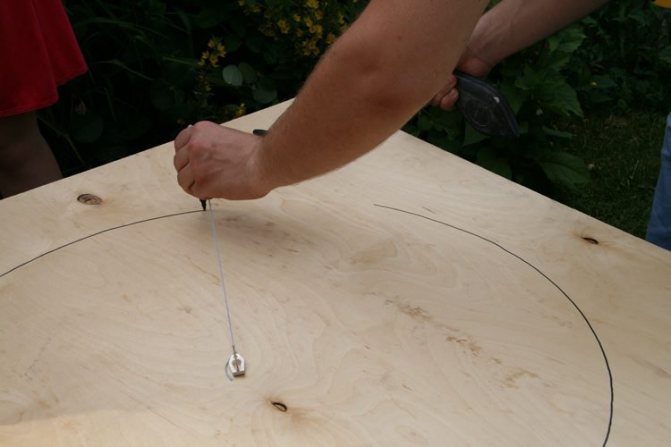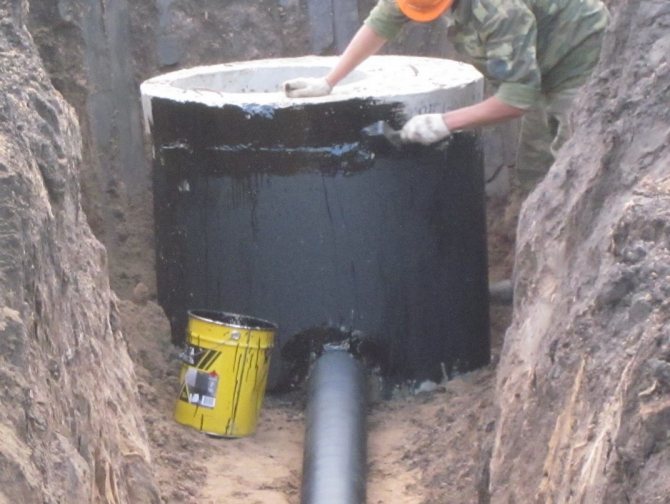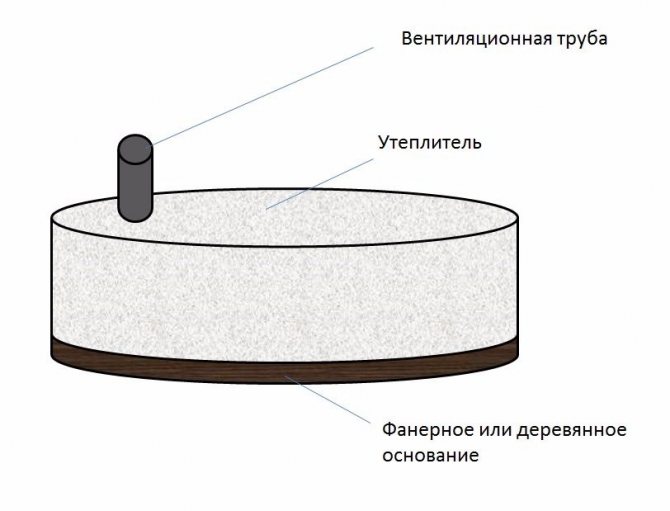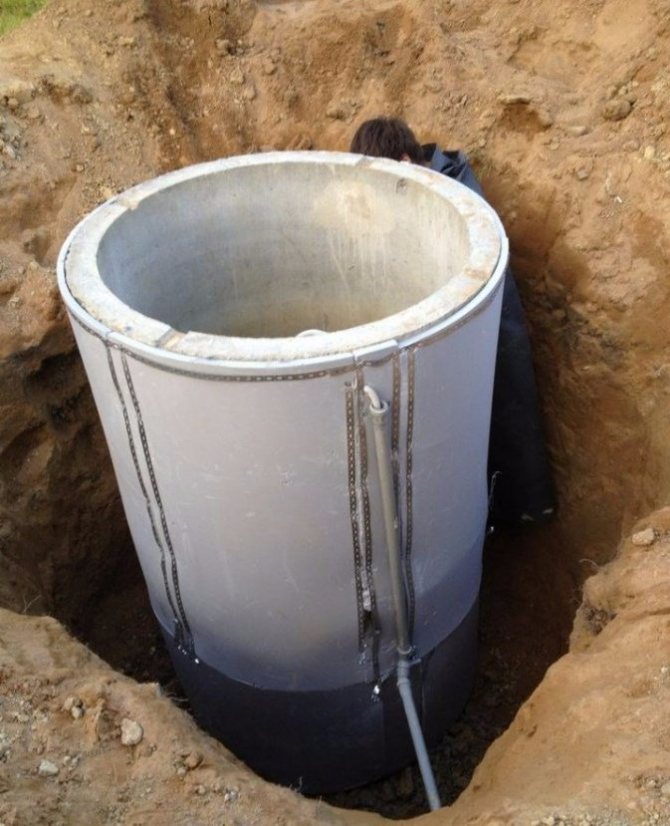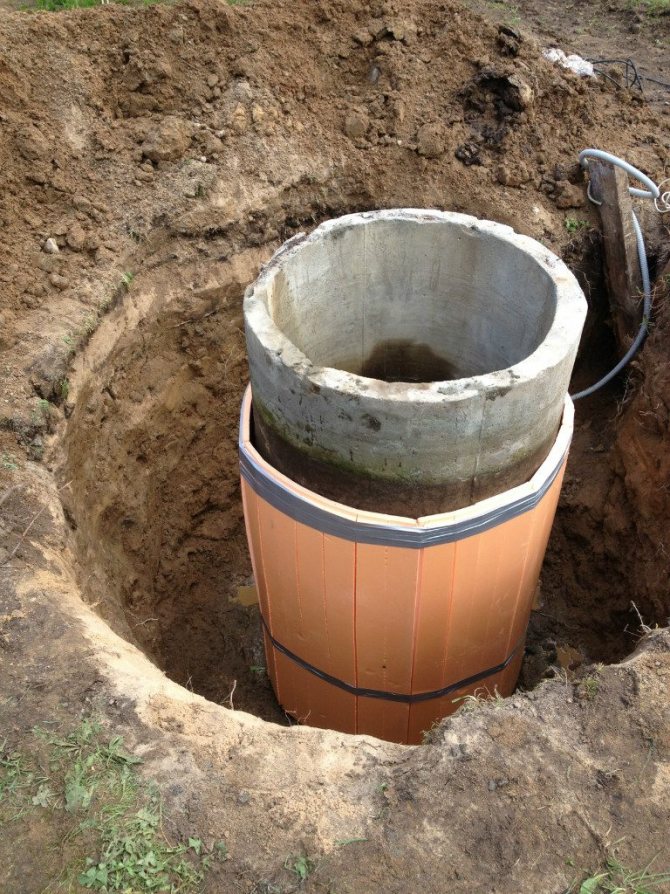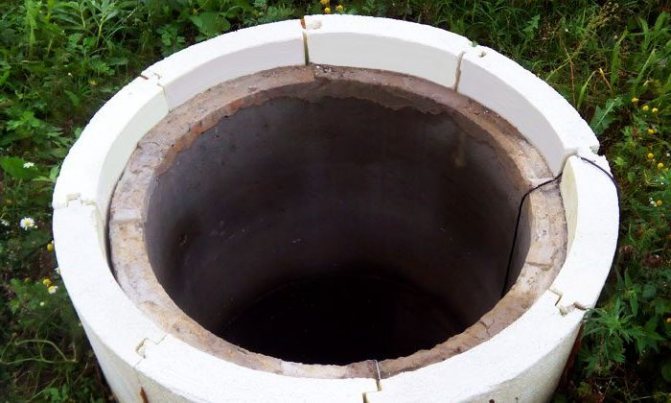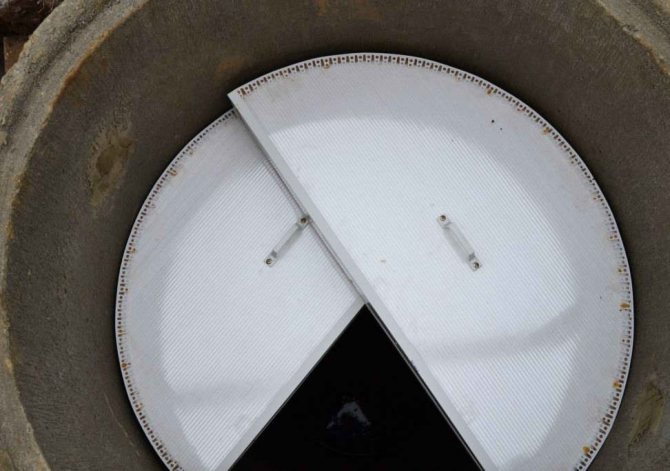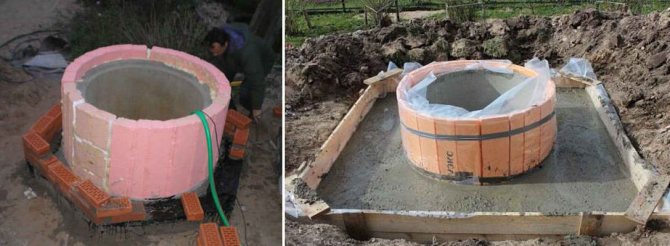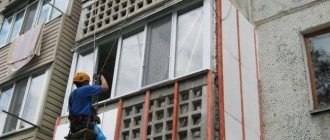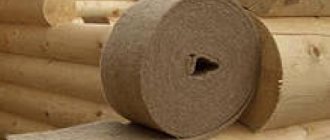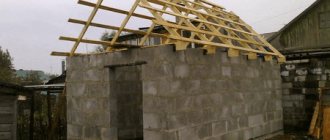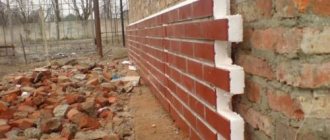Insulation of a summer cottage well from concrete rings
Insulating the topmost ring of the well is actually not so problematic. The technique of this procedure is quite clear and primitive. If you explain briefly and concisely, then the upper ring of concrete should be pasted over with polystyrene foam familiar to everyone.
Let's consider in detail the progress of work to be performed
- The wall ring needs to be dug out twenty centimeters - to the depth of soil freezing. In total, you will have to go deep about 1.2 meters. Since this is not very comfortable to do, you will have to dig a rather large pit. If you count the rings from above, then it is enough to do with a depth of 20 cm below the junction of the first 2 rings.
- We take layers of foamed polymer and cut it into strips 20 cm wide. High density material is more suitable, and the best option would be to purchase extruded or ordinary foam.
- We clean the wall rings from dust and dirt, moisten them with water, glue parts of the prepared foamed polymer with a special glue.
- When the surface of the ring is fully pasted over, the gaps between the individual strips of foam polymer are filled with foam for installation. Its remains are cut off after complete drying, the soil around the well is poured, the well itself is put in order.
So that the foam for installation work does not burn out in the sun, and the foam polymer does not deteriorate, the structure is reinforced with a mesh, then covered with a plaster layer. This option is very effective, but it does not help in all cases for sure: the cold can penetrate through the top.
Thanks to this, it will be better, without delay, to move on to the next method of insulation with your own hands.
Making a warm shutter
What is a warm shutter?
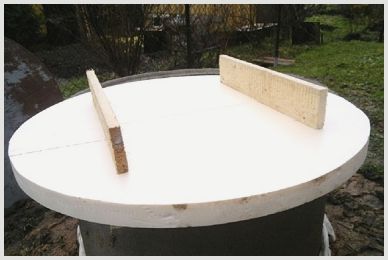
It must be stated that this is a specialized cork with small holes made in it. One of them serves for ventilation and prevents deterioration of water. The second is intended for the intake hose. This option will be optimal for a summer cottage, which is supplied with well water using a pump.
How to make such a shutter cover?
- It is necessary to make two similar rings from plywood resistant to moisture, corresponding to their own dimensions to the inner diameter of the concrete ring of the well.
- One of the rings is pasted over with 5 cm polystyrene foam. All residues are carefully cut off: the foam circle must exactly repeat the shape of the plywood one.
- The second plywood circle is glued on top of the foamed resin.
- Final stage. We drill two 6-centimeter holes (for ventilation and for a hose), we make a handle to which we attach a thick rope or chain, so that in the spring you can easily remove this plug.
There is nothing difficult in all these events, but there is also no special beauty here.
It should be noted that the considered methods of thermal insulation with foamed polystyrene are suitable only if the water supply is performed using a pump.
If the water comes out of the well with a bucket and a collar, then it is unlikely that the cork will help. In this case, there is another, 3rd method of insulating the well with your own hands.
Insulation of water wells
This is an excellent option for every occasion. There is an optimal way of thermal insulation of a well, which solves several problems at the same time: both the view of the site outside the city will not be able to suffer at all, and the insulation will actually be done with high quality.This primitive and good method is the construction of a special closed well house.
Closed well house
This design solves the following tasks:
- Prevents water from clogging up with foliage and other small debris. A well-thought-out and sealed house with a tight lid will not allow anything unnecessary to get into the source.
- The well will not freeze during the winter. In the only case, such a house will not save from freezing if the water level in the well is higher than the level of ground freezing. If this is the case, then it will also be necessary to implement additional insulation of the upper ring of the wall polystyrene foam.
If you find it too difficult to insulate the well yourself, you can make it easier for yourself. At the very least, you will not need to do most of the work yourself. Foam half rings, a warm shutter and the sealed good houses themselves can be purchased at hardware stores.
All you need to do is install such products, and this, of course, is several times easier. Well, pre-made products, in most cases, will look much more beautiful than home-made ones. Moreover, this applies to a house for a well. All the same, only self-made interior items will give the site an original and distinctive look.
Well insulation materials and work
It is much easier and cheaper to insulate a well before winter than to repair it, eliminating defects in waterproofing, and sometimes replacing the rings. The use of modern materials makes the task not only easy to accomplish, but also available for an independent solution.
Before carrying out thermal insulation work around the head, it is necessary to remove part of the soil - to dig a trench, cleaning the walls of the mine. The depth of the pit is the sum of the freezing depth and an additional 0.5-1 m for reliable insulation.
Insulation: foam
Among the main advantages of foam plastic are low cost and ease of installation. In addition, the material has the following characteristics:
- does not conduct heat well;
- does not corrode and rot, does not decompose in the soil;
- has a low coefficient of moisture absorption;
- does not deform under pressure.
For insulation of a well, large hardware stores offer semi-cylindrical parts equipped with grooves and protrusions. When using such a shell, the insulation process will take only a few hours. If it is not possible to buy ready-made parts, then the insulation is carried out with foam plates, cutting them into strips of the required width.
Along with the foam, it is advisable to purchase glue for facade work, as well as a vapor barrier membrane (polyethylene or special materials).
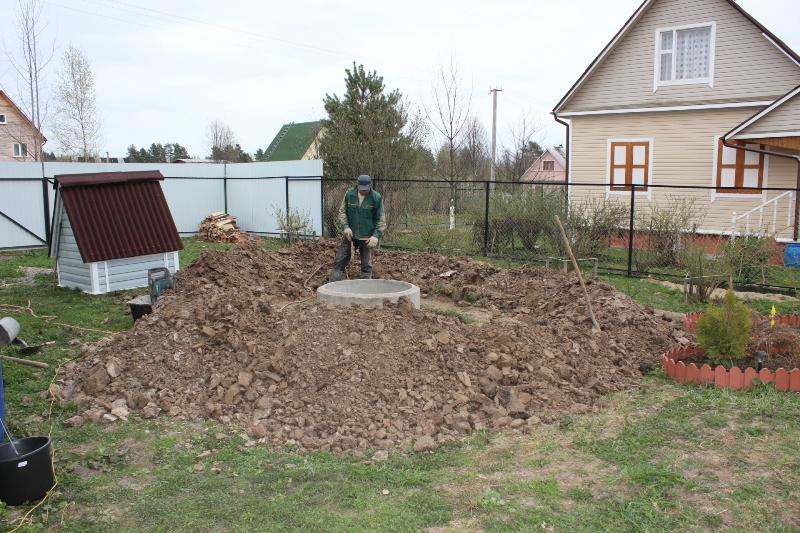

In the first step, you need to go deep to 2 rings.


It is necessary, if necessary, to coat cracks and chips with cement mortar.
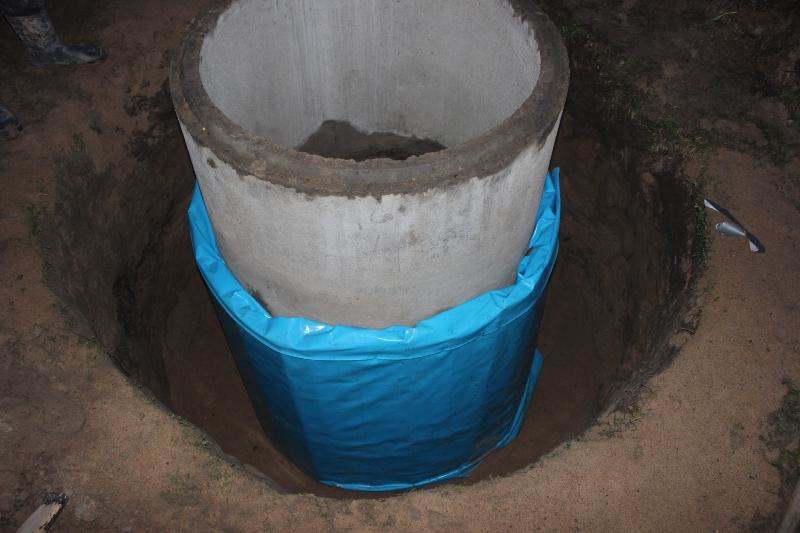

The first layer should be applied with a waterproofing film, then foam + foam, it is advisable to tie it on top with a dense material.


Preparing for the blind area.
The work is carried out in the following order:
- thoroughly clean concrete from soil residues and other dirt;
- facade glue is applied to the inner surface of half rings or cut plates (you can take liquid nails, Moment-installation, etc.);
- tightly pressing the foam to the surface, cover all the walls from the outside, from the bottom of the excavated pit to the edge of the head;
- when using half rings, parts of the locks on the sides are combined, and the plates are placed as close to each other as possible.
When using a foam board, the joints of adjacent parts will be loose. The gaps must be filled with polyurethane foam. Further work is carried out after it dries.
When the insulating cladding is finished, and the protruding parts of the foam are cut off, it remains to make the outer vapor barrier layer of the film. Wrap the material around the shaft covered with foam and fix it with glue.Fill the excavated pit with excavated soil, ramming it as the hole is filled.
Insulation: extruded polystyrene foam
Thermal insulation of a well with expanded polystyrene is not too different from thermal insulation with foam. EPPS is also produced in the form of plates or shells for large-diameter pipelines.


Preparatory work.
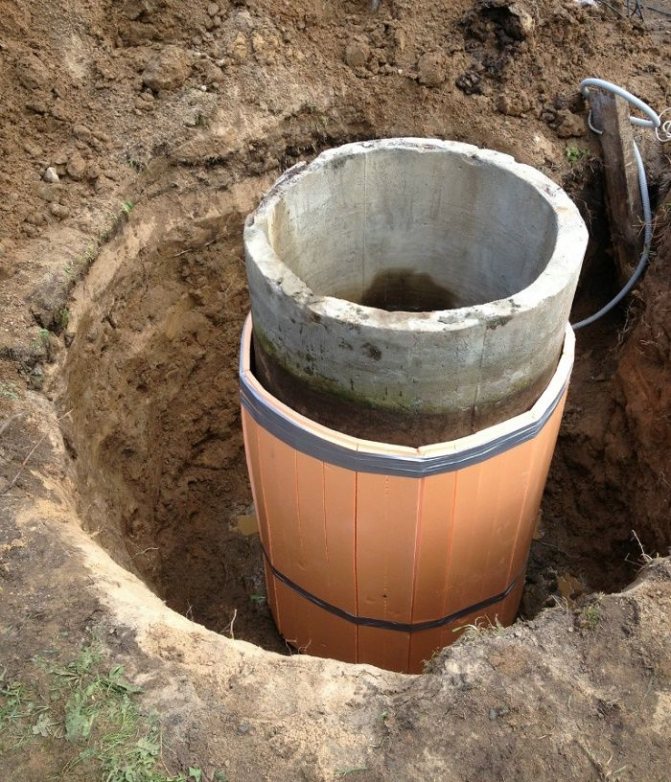

Insulation of the walls of the well
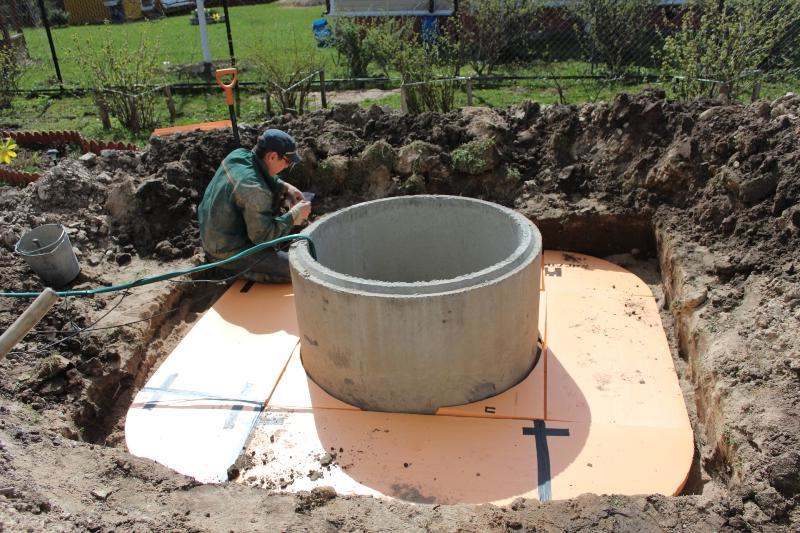

preparation for the blind area and insulation
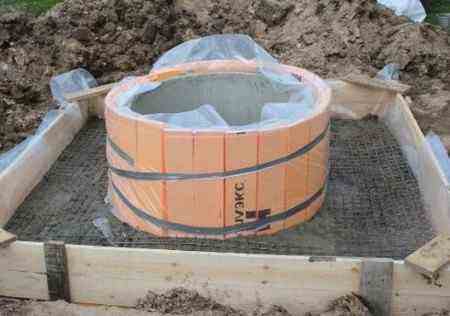

Reinforced blind area
Insulating material differs from foam only in increased strength and resistance to external influences. It is slightly damaged by rodents or insects, has practically zero moisture absorption coefficient.
EPPS is produced by Russian companies that produce heat-insulating materials. It is as easy to buy this type of thermal insulation as polystyrene, but the cost of penoplex and similar EPS will be 20-30% higher.
Insulation: cellular polymeric materials
To insulate the well with your own hands, you can also use rolled polymeric materials with a porous structure (isolon, tilit, foam, etc.). A number of offered brands have an adhesive layer and do not require the use of other materials for mounting on the outer surface of the rings.


To save money, it is recommended to use non-foil materials, since the function of the foil is to reflect heat inside the room, and it will not be in demand when arranging a well.
The peculiarity of cellular coatings is their plasticity. With a strip of material, you can simply wrap the prepared pipe from reinforced concrete rings, gluing the isolon to the surface. Knowledge of the technology, how to properly lay the insulating layer, will help to do everything quickly and efficiently:
- clean the concrete surface;
- cover it with a primer (for example, under adhesive for facade tiles);
- if the roll material does not have an adhesive surface, apply liquid nails or another composition to the inside;
- pressing over the entire surface, glue a strip of material;
- glue the joint with tape;
- fill the pit.
Insulation: polyurethane foam
Warming of wells for the winter with your own hands can also be done with special mixtures based on polyurethane. You can buy the material in the form of a dry powder, diluted with water before use, and as a ready-made composition in a spray bottle.
The second method is better suited for independent work, since it does not require a search for special equipment for spraying.
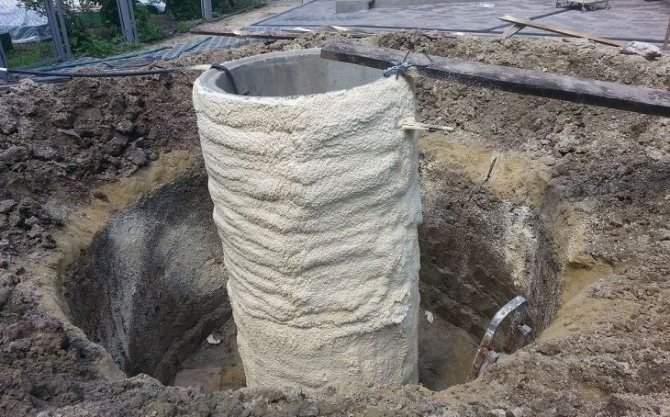

According to the method of application, polyurethane treatment resembles working with polyurethane foam, only you will not have to fill the gaps, but spray the composition onto the surface of the pipe.
Preparation and insulation are carried out as follows:
- clean concrete from contamination;
- primed with a primer for polyurethane;
- apply a uniform layer of foam;
- leave until complete hardening (4-5 hours, unless otherwise indicated in the instructions);
- paint the surface of polyurethane foam with paint for outdoor use and dry it;
- bury a trench.
The head above the ground can be sheathed with a sheet of tin, as builders do when insulating pipes for a heating plant. This will protect the surface of the shell from mechanical stress and the influence of ultraviolet radiation.
Why you can't use mineral wool
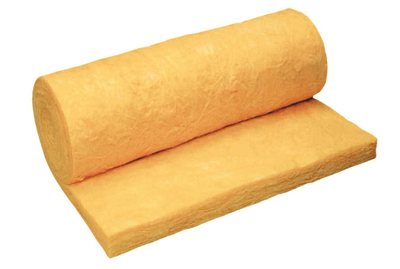

The main disadvantage of mineral wool is the ability to absorb moisture from the environment. The head and underground parts of the pipe are affected by precipitation, groundwater, and liquid spilled from the bucket.
It will not be possible to protect the porous material from moisture impregnation even with the help of waterproof membranes. Wet mineral wool loses its thermal insulation properties.
In what cases is insulation required
If the well was built according to ancient traditions (read: made of wood), then, of course, it does not need any thermal insulation. There are also exceptions - for example, the well cover needs to be insulated.In this case, it is necessary to make an additional cover of wood and fix it inside the structure itself. This cover will protect the suburban well from:
- falling snow;
- temperature differences;
- dry leaves and other debris.
Note that almost all modern wells are constructed using reinforced concrete rings. Such wells have numerous advantages, including:
- strength;
- reliability;
- durability;
- ease of installation and further maintenance.
Despite this, they have one significant drawback: they need to be insulated for the winter.
On a note! If the water in the structure is located below the freezing level of the soil, then the structure itself will not freeze. But if it is higher, then the installation of an insulating material is required!
There are three thermal insulation technologies at once:
- insulation of the cover of the structure;
- thermal insulation of the upper ring;
- construction of a decorative house.
Let's get acquainted with each of the possible methods in more detail.
Method two. We thermally insulate the upper ring of the structure
Each specialist will tell you that in order to prevent freezing of the well, it is necessary to reduce the thermal conductivity of its upper ring. This method of thermal insulation is performed in two ways:
- by means of foam;
- by means of polyurethane foam.
Let's look at the first method first.
We use expanded polystyrene for the ring "under the fur coat"
Here you should prepare the following consumables for work:
- polyurethane foam;
- paint;
- plaster;
- insulation blocks made of polystyrene foam, which are connected according to the "thorn-groove" system.
On a note! According to this technology, the first ring from above will be completely insulated, while the second only partially. Now to work!


Step one. Work should start with preparatory activities. Around the ring, dig a pit 20 centimeters wide and approximately 0.5 meters deep. Then thoroughly clean the surfaces of dirt and install the first ball of the "fur coat". At this time, make sure that the density of all compounds is maximum! Blow out the joints with polyurethane foam in order to seal them. Having finished with the first level, proceed to assembling the second and gluing it to the ring. Blow out the cracks that have formed between the layers with foam.
Step two. Next, start plastering the surface of the rings. This will protect the foam from the negative effects of the sun's rays, which, as we know, worsen the thermal insulation properties of this material. After the plaster is completely dry, apply paint to it - this will prevent the finish from getting wet.
Step three. It remains only to fill up the pit and carefully compact the earth.
Penoplex, we insulate the foundation reliably and correctly
We advise you to read our article on self-insulation of the foundation. Learn more here
We use polyurethane foam for the ring "under the fur coat"
If you have chosen polyurethane foam as insulation, then follow these steps. First, dig a similar pit (as in the previous method of insulating a well for the winter), and then build a frame made of wood around the first ring. But this is in general terms, we will analyze the procedure in more detail. Prepare the following materials for work:
- paint;
- dowels;
- polyurethane foam sprayer;
- collapsible metal formwork;
- plaster;
- a piece of plastic wrap;
- wooden bars.
Step one. Traditionally, start by digging a pit, but narrower (maximum 10 centimeters). After that, place the bars around the first ring in increments of about 40 centimeters. Cover the edges of the trench with a formwork made of thin sheet steel, which will follow all the contours exactly. Cover the formwork with prepared foil.For what? This is explained by the fact that the adhesion of the foam is very significant, and therefore the dismantling of the formwork is impossible.
Step two. Having finished with the construction of the formwork, you will notice that a void has formed between it and the ring - then you need to fill it with insulation. At the end of the pouring, the polyurethane foam will increase in volume, and the trench will therefore be filled as tightly as possible.
After that, you need to wait until the material is completely dry. As soon as this happens, dismantle the formwork. Plaster the finished surface and apply a coat of paint to it. Cover the void left after the formwork with earth and carefully tamp it.
On a note! It is also advisable to cover the well with a lid, which was described in one of the previous paragraphs of the article.
Materials and production technology
It is advisable to carry out thermal insulation measures at the stage of construction of the structure. In this situation, you can immediately get a year-round source of water, which will not require repair for a long time.
Do-it-yourself insulation of a well with expanded polystyrene during construction will be cheaper. If the structure has already been put into operation, then labor-intensive earthworks will have to be carried out - digging a trench around the rings and fixing the insulator. A process such as insulating a well from concrete rings for the winter requires a competent approach and the use of high-quality material.
Styrofoam
It is a synthetic polymer used to insulate any structures. Foam has many advantages:
- excellent thermal conductivity;
- low water absorption;
- ease of use;
- minimal deformation;
- low cost.
The main advantage of this type of insulation is that it is produced in the form of semicircular elements, which are exactly suitable for insulating reinforced concrete rings. Thanks to this material, the well can be insulated using a simple technology:
- Prepare the surface - remove dirt and debris.
- Installation of polystyrene half-rings on facade glue.
- Reinforcement of the structure with special dowel nails.
- Arrangement of a vapor barrier.
- Filling the trench around the well with soil.
- Compaction of the soil.
Despite the simplicity of the arrangement and the inexpensive cost of the material, one cannot but mention the disadvantages of foam - it emits harmful substances under the influence of sunlight, and can be damaged by rodents and insects.
Extruded polystyrene foam
When asked whether it is necessary to insulate the well for the winter, the answer is unequivocal, yes. Expanded polystyrene is an improved foam that has the following differences:
- increased thermal conductivity;
- resistance to temperature extremes;
- insensitivity to the effects of an aggressive environment.
The material can withstand increased mechanical stress, therefore it is widely used in the laying of underground communication systems. To insulate well rings, you can use a material of domestic or foreign production, but it should be understood that foreign material is much more expensive than Russian counterparts.
For thermal insulation, plates of a minimum cross-section are used, since they fit tightly to a round structure. To maximize insulation, the joints between the elements are filled with polyurethane foam. So that groundwater does not damage the insulating layer, it is additionally protected with a roll-on waterproofing agent.
The main advantages of the material:
- resistance to deformation;
- mold and corrosion do not appear on it;
- durability - the thermal insulation layer will last more than 25 years.
If the insulation is used on the outer part of the well, then it is necessary to make additional fixation with special brackets.
Cellular polymeric materials
These are polymer-based thermal insulation materials that are often used in construction. Cellular insulation has many advantages:
- plastic;
- resistance to humid environment;
- high thermal insulation characteristics.
This material is very convenient to use when insulating reinforced concrete rings. The most common type is izolon, produced in the form of rolls with a self-adhesive layer, thanks to which it is possible not to use additional compounds for fastening to reinforced concrete walls.
The algorithm for warming with a cellular insulator consists of the following actions:
- Preparation of external walls.
- Application of a deep penetration primer - this will help increase the adhesion of the material to the surface.
- If the material is not self-adhesive, then apply a compound for outdoor use.
- Insulation of joints with metallized tape.
- Ditch filling and soil compaction.
One of the types of cellular material is foam glass, but it is practically not used in private construction due to its high cost.
Polyurethane foam
This type of heat insulator has unique properties:
- resistance to aggressive environment and moisture;
- high thermal insulation properties;
- mold and mildew do not form on it;
- not subject to attacks by insects and rodents;
- long service life - 50 years.
Manufacturers offer customers two types of this material - in cylinders, ready to use, in a dry form, which will first have to be diluted.
To apply this heat insulator, a special technique is used that helps to apply the foam in an even layer.
Instructions for use are as follows:
- Prepare the surface and apply a deep penetration primer to it.
- Prepare the composition strictly according to the instructions.
- Tool preparation and application of material to a concrete surface.
- The outer part of the walls of the well is painted with a special paint for external use.
The main advantage of this type of heat insulator is that the layer is uniform without seam joints.
The composition is applied very quickly and hardens in a few minutes, the final strength of the polyurethane foam is gaining within 5 hours.
Among the shortcomings, one can note the high cost and the use of special equipment, therefore it will not be possible to equip the heat-insulating layer without the help of specialists, and their work will also have to be paid.
Construction of a decorative house
The advantages of the house are that it not only insulates the well, but protects the source from dirt and decorates the site as an element of landscape design. Types of well houses:
- roof mounted on mine rings;
- a log house that looks like a gazebo;
- large 2-pitched roof covering concrete rings;
- with a canopy;
- with a winch.
Materials for its construction:
- Brick, building blocks or concrete. With their help, the structure can be given any shape. It is durable and inexpensive, but needs cladding.
- Metal. This option is chosen by lovers of high-tech style. The metal frame is sheathed with sheet metal.
- Natural stone. It is easier to lay flagstone because it is flatter. The house looks natural from it.
- Wood. Due to its high performance and aesthetic appearance, it is chosen most often.
Too thick walls will make the structure bulky, and thin, lightweight structures will not withstand wind and other loads.
The house should not stand on the ground, but on a concrete site. Therefore, work begins with it, taking into account the following:
- the site must be reinforced;
- concrete layer - at least 15 cm;
- it is necessary to make a slope for water flow;
- if a project with a canopy and a winch is selected, the racks for them are installed before the site is poured.
The stages of building a house depend on the materials chosen, but installation always begins with the construction of a frame. After that, the space between the walls of the house and the well is insulated, for example, with expanded clay. The structure is decorated with carvings, painting parts in different colors, artificial aging of wooden surfaces, and setting figures made of wood or plaster.
How to insulate a water well for the winter
The simplest situation is when the minimum air temperature in winter is about -15 ° C. Under these conditions, it is possible to provide thermal insulation of the well with the simplest materials. The role of them is ordinary straw, sawdust, dried leaves. But this option is far from always appropriate, since sometimes the well is located in the ground, which freezes quite strongly. Then you should choose mineral wool, glass wool, polystyrene plates.
These thermal insulation coatings are well suited for protecting wells equipped with an electric pump. In this case, the thermal insulation layer must have a minimum thickness of 30 cm.The pipe and insulation must be separated by a free space of about 5 cm wide.
When choosing an insulating material, it is important to make sure that it is easy to fit on its own, exhibits high moisture resistance and is highly durable. When it is necessary to perform thermal insulation of pipes with many bends or bends, it is better to choose rolled thermal insulation. A waterproofing layer is then applied on top of it, which is simply wrapped over the thermal insulation several times.
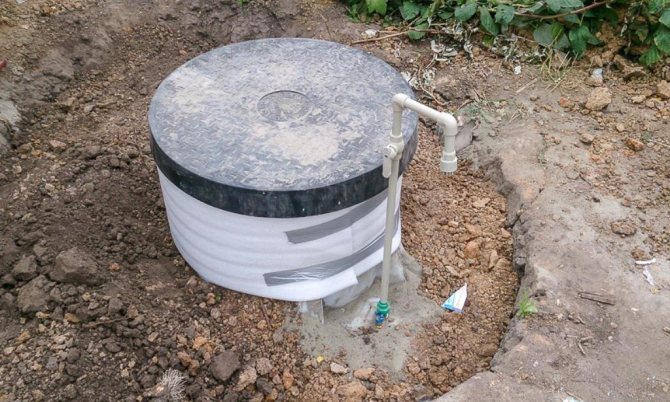

If the owner wants to avoid the need to carry out additional waterproofing work, it is still better for him to immediately purchase a material that has high moisture resistance. The thermal insulation provided by such materials is sufficient to keep the water well in good condition. Moreover, moisture-resistant insulation is not so expensive that it was necessary to abandon them in order to save money.
Preventing the well from freezing
So that with the onset of winter the well structure does not freeze, thermal insulation should be taken care of even during its construction. If the suburban area will be visited occasionally (for example, exclusively on weekends), then, in principle, it is not necessary to insulate the well. In such cases, it is only necessary to clean it and treat it with some kind of disinfectant (such as chloramine) before leaving.
After that, completely pump out the water and close the structure with a lid. Lay a plastic wrap on top of the lid and cover it all with leaves. Now you can go to the city with a clear conscience, because with the onset of heat, the well will again provide clean water.
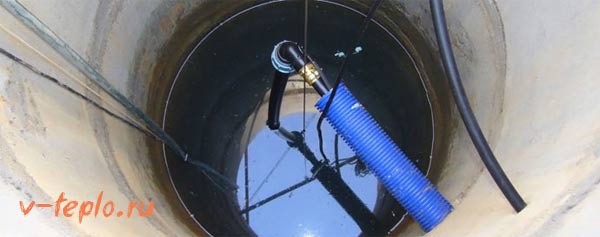

But if the well is operated regularly, then the measures should be more serious. For example, pipes to the house should be located below the soil freezing line, the structure itself should be protected by the house described above, or by other available means.
Why did the water freeze in the well in winter?
- First, the material from which the well was built matters. If this is a tree, then you can calm down: the bucket in it will never hit the ice. If in doubt, remember what they were made of several centuries ago. But now they use reinforced concrete, which, if some factors coincide, can leave its owners without life-giving moisture.


Wooden wells at any time of the year, even in the most severe winters, made it possible to collect water for the farm
- Secondly, the water level in the well. If the area is swampy and the water is only 1.5-2 meters away, then, of course, the risk of seeing the ice shell is very high. Well, if the well is deep and the water is 8-10 meters above ground level, then there is nothing to worry about.
- Thirdly, the depth of soil freezing. In the middle lane and southern regions, where the ground freezes for a meter and a half, the well will not freeze, even reinforced concrete. Water is usually below this mark. But if the soil can freeze by two to four meters, it is imperative to insulate the well. So the well, and the nerves, and the money will be safe.
Method three. Construction of a wooden house
If your site is located in an area where the temperature in winter is not too low, you can build a protective wooden frame on top of the mine.To do this, prepare:
- wire;
- nails;
- waterproof film;
- logs;
- plywood sheets;
- expanded polystyrene.
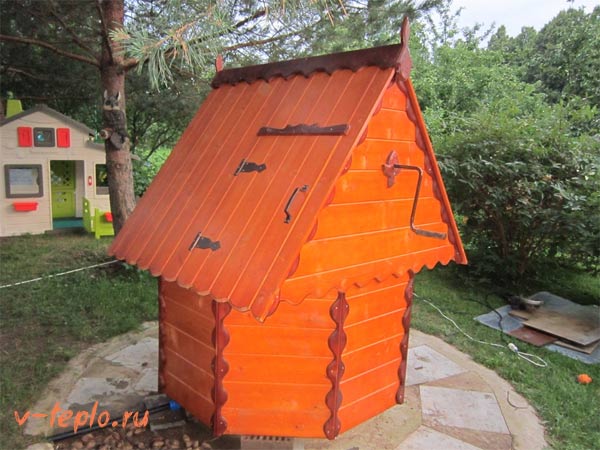

Step one. First of all, cover the inside of the top ring with a pre-prepared film. Next, take the styrofoam and cut six rectangles out of it. Make the sizes of the latter such that an even hexagon is formed as a result of covering the ring. This little trick will significantly increase the adhesion density of the foam.
Step two. Then you need to fix the foam. To do this, cover it with at least three rings of ordinary wire. It is advisable to use aluminum wire for this, since it does not rust and is quite soft. As a result, it will be easy to manipulate, and there will be no corrosion on the surface of the insulating layer.
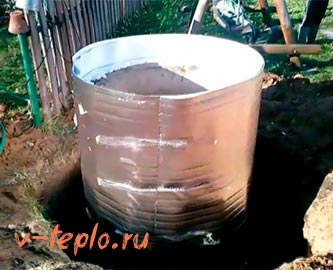

Step three. After that, build a blockhouse of small logs. In height, the log house must be flush with the well itself, and its shape must be hexagonal. Lay a cover consisting of several layers on top of the finished house (as described in the first method of insulation). Then you can paint the structure so that it is not only functional, but also aesthetic.
Video - House installation
For a more detailed acquaintance with the technology, we advise you to watch the thematic video material.
https://youtube.com/watch?v=zFxBdPaUM
Why is freezing of wells dangerous
It is a mistake to think that well insulation is necessary only when it is used all year round. Many summer residents and seasonal residents of country houses sincerely do not understand why to insulate a well, which no one uses in winter anyway. Meanwhile, such seasonal wells also need effective thermal insulation!
Otherwise, a variety of problems may arise, making the operation of the well difficult or completely impossible:
- the formation of an ice plug in the water supply system;
- displacement of the rings resulting from the expansion of frozen water in the enclosing soils;
- breakdown of the ice plug and damage to pumping equipment;
- divergence of the joints of reinforced concrete rings when water gets between the seams.
Wells that are not protected from low temperatures much more often require repair work. And in terms of financial costs, repair activities are often more significant than one-time insulation work.
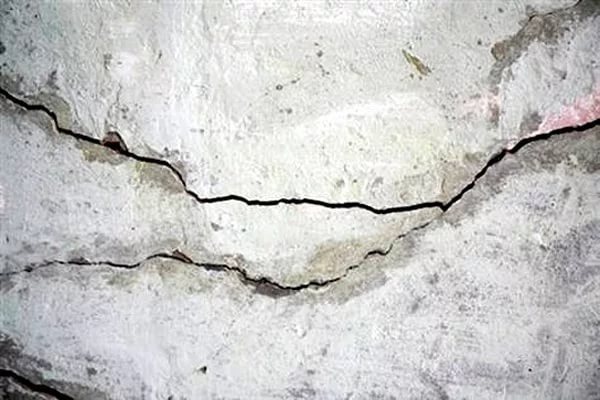

If a water supply system based on a well is arranged in a suburban area, then in addition to the mine itself, it is required to insulate the pipes to protect the supply line of the system from low temperatures.
Measures against freezing
When installing a well on a site, masters advise you to think in advance about the possibility of freezing it in winter period.
Already during the digging of a drinking water source, its construction, a number of works are being carried out to protection concrete structure
Even if it is used for a short period of time, a number of protective measures are required.
This will help keep the purity, quantity and quality of water, the serviceability of devices and devices for its collection for a longer time. Necessary actions:
- processing of walls of a log house disinfectants means;
- pumping water and drying the log house;
- laying water pipes at the required level: below the level of soil freezing;
- additional arrangement of pipes and fastenings of pumping equipment;
- protection of concrete from impact natural phenomenadestroying its quality.
Method one. Cover insulation
This technology is not complicated and consists in the installation of an additional cover inside the structure itself at the ground level. We remind you that water from a well can be obtained in two ways - in the old fashioned way, that is, with the help of buckets, and by means of an electric pump. This article discusses an exceptionally modern method.
You should start by preparing everything you need. Prepare for work:
- plywood sheet;
- glue;
- wire;
- a plastic pipe, which is necessary for ventilation;
- insulation, the thickness of which will be at least 5 centimeters (foam is ideal for this);
- polyurethane foam.
After that, proceed directly to the construction process.
Step one. Take a plywood sheet and cut out a pair of even circles with a diameter similar to the diameter of the structure itself. Make two holes in each circle - one for the hose and the other for ventilation.
On a note! Ventilation in this case is mandatory, because without it, the water will soon begin to smell unpleasant, and its taste will noticeably deteriorate.
The diameter of the drilled holes is insignificant - no more than 6 centimeters, otherwise frosty air will be able to penetrate through the cracks formed. It is more convenient to drill holes at one edge. Next, along the perimeter of the second circle, make 4 more holes for the wire.
Step two. We continue to warm the well for the winter. Cut out a third circle of the same diameter, but this time from the foam. Stick it on the bottom circle using good quality wood glue, and fix the third circle on top. Once the glue is dry, place a ventilation pipe in the prepared hole. You can use polyurethane foam as a joint seal.
Step three. The work is almost finished, all that remains is to make a special ring out of the wire. To do this, take it and wrap the first ring, thereby fixing its circumference. Then attach the wire to the ring, which is fixed in the four holes of the lower ring. Pass the hose into the required hole and then lower the finished sandwich onto the ground line. The lid will be held with a wire, the well will be properly ventilated, but the water will not freeze.
Well cover and wooden house
To ensure the best protection of the well from freezing, in addition to the insulation of the well shaft, it is also necessary to carry out work on external insulation. They consist in arranging and insulating the cover of the well and / or erecting a wooden house above the well.
The cover for the well must be installed taking into account the maximum water level. The movement of the cover is provided with a cable or rope. The best material for making a cover is wood. Also an excellent option would be a three-layer cover made of two layers of thick plywood with insulation between them.
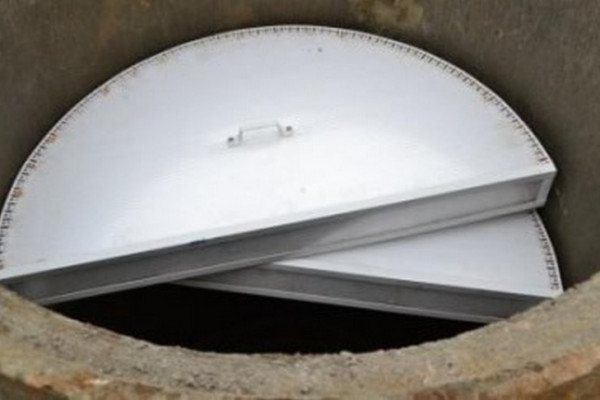

It is advisable to use expanded polystyrene or polystyrene as a heater.
If you decide to use a well cover made of reinforced concrete, then it must also be insulated by attaching a layer of foam or other insulation. Fastening is carried out using glue for outdoor use and dowel-nails for concrete.
Installing a house over a well is a more costly method, however, it has its advantages:
- reliable shelter of the well shaft from the ingress of debris, precipitation;
- the ability to use the well in any weather (rain, strong wind);
- aesthetic appearance, a wooden house is perceived as an element of landscape design.
You can make such a wooden house yourself or buy a ready-made version. In any case, it is worth knowing that the house is not simply installed on the surface of the earth. He needs a foundation, which is performed as follows: the area around the well is leveled and a blind area is made, on which a layer of fine gravel is poured or tiles are laid.
After that, a wooden house is mounted, and the space between it and the reinforced concrete ring is filled with insulation. In this case, expanded clay, an inexpensive bulk material, can be used as a heater.
How to insulate a well for the winter with your own hands
In order to properly insulate a concrete well, a certain technology must be followed.It depends on the type of insulation material used.
Thermal insulation of a well from concrete rings with penoplex
For work on the insulation of the well, the following materials and tools will be required:
- sheets of extruded polystyrene foam (foam);
- polyurethane foam for processing joints;
- finishing;
- a sharp knife for cutting insulation;
- garden shovel;
- wheelbarrow;
- screwdriver;
- saw;
- glue;
- fasteners (hardware).
The step-by-step process of thermal insulation with penoplex is as follows:
- Dig a foundation pit from 0.5 m around the well.This depth will be enough to carry out external thermal insulation of the concrete structure.
- Glue penoplex onto concrete rings. It must be cut into pieces 100 mm wide. There should be 2 layers, the next one goes with the overlap of the seams of the first.
- Foam the docking places, otherwise the hydraulic structure will freeze through.
The insulated well can be lined with profiled sheets. They are mounted on a pre-installed frame with self-tapping screws. Alternatively, instead of corrugated board, you can use street tiles, stone, fixing them on an adhesive for outdoor use. For better fixing, it is recommended to fix the cladding to the mesh with dowels.
Well insulation with expanded polystyrene
To protect the well from freezing, you will need:
- polyurethane foam;
- plaster;
- paint;
- expanded polystyrene plates.
Insulation instructions for a concrete hydraulic structure:
- Around the well, make a pit 20 cm wide and 50 cm deep. In order for the heat insulator to perform its function more efficiently, the walls of the well must be cleaned of soil.
- Lay the first layer of expanded polystyrene blocks, minimizing the gaps between them as much as possible. For sealing, the joints are foamed. Similarly, the second layer is laid on the well.
- Plaster the insulating material. Thanks to this technique, it will be possible to prevent the destruction of the thermal insulation layer as a result of exposure to the sun. When the plaster is completely dry, proceed to painting. Fill up the pit, tamp the soil.
Insulation of a well in the country with polyurethane foam
Of the necessary materials and tools, you need to prepare:
- collapsible version of metal formwork;
- wooden bars;
- dowels;
- polyurethane foam sprayer;
- paint;
- plaster;
- polyethylene material.
Detailed instructions for insulating a well:
- Form a pit with a width of no more than 10 cm.
- Place wooden blocks around the first ring at a distance of 40 cm from each other. After that, make the formwork from sheet steel according to the contours of the hydraulic structure. Lay plastic wrap inside. Fill the trench with polyurethane foam. At the end of drying, the formwork is removed.
- Plaster and paint the surface.
Warming with cellular polymeric materials
Since the insulation is produced in a roll form, it is quite easy and simple to perform thermal insulation of reinforced concrete rings. Most of the materials are self-adhesive, which excludes additional fixation to the concrete surface. The whole process consists of the following points:
- Carry out preparatory measures on the outside of the well. The treatment is carried out using a special primer to increase the adhesion of the concrete surface and heat insulator.
- If the insulation does not have an adhesive base, it must be fixed by using outdoor glue. Docking points must be glued with tape.
- At the end of the work, the trench is covered with soil, tamped.
Among the widely used cellular materials on a mineral basis, foam glass can be noted; it is made by foaming silicate chips using a special technology. The material is endowed with such positive characteristics as environmental friendliness, ease of use, and a good degree of thermal insulation. Of the shortcomings, only high cost is distinguished.
Why is it necessary to carry out insulation
By insulating the well, it will be possible to preserve a satisfactory temperature inside it, allowing the water to remain in liquid form even in high frosts, without forming ice on the surface.
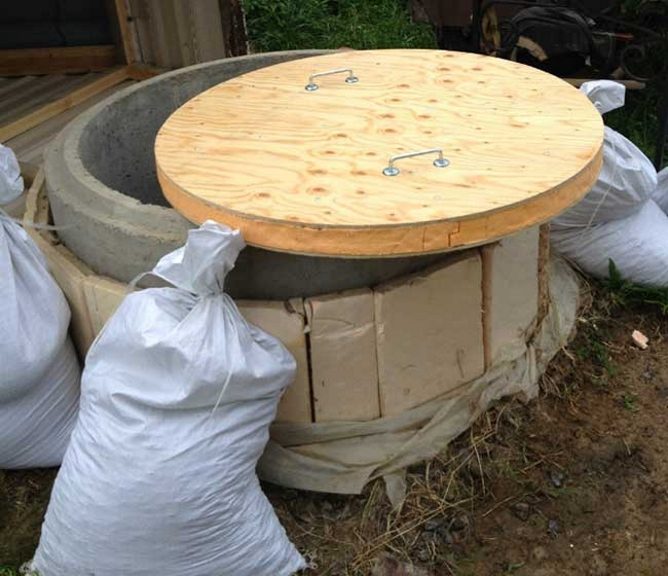

The formation of an ice layer bothers not only the collection of liquid, but can also lead to cracks on concrete circles, or harm the wires or pipes that are located in the well.
The circles begin to break down and age ahead of schedule. As a result, their service life is significantly reduced. In the event of freezing pipes or damage to cables, repairs will be necessary, which will not be cheap and will require time-consuming processes.
The need for insulation for the winter
Under certain conditions, the water in the well freezes, which means that its insulation for the winter is an important aspect in order to keep the water supply working throughout the year.
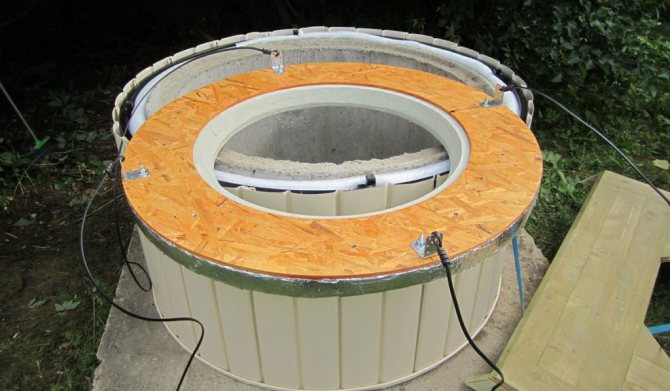

Before insulating the well, you should first watch the training videos with the master class
Often, a dacha well is used when it is warm. How and what to insulate and cover the well, it is better to think in advance. The settling of well water and cyclic freezing leads to a gradual destruction of the structure, and the pump fails (periodically). If the well is made of concrete rings, the seams between the rings may shift and break. Because of this, all communications leading to the house may be cut off, and the integrity of the pipe connection will suffer. Violations around the ring will be visually indicated by soil subsidence. The work required to fix the problem will be time consuming and costly, and the residents of the house will be left without water for a long period.
The reasons for the freezing of the well:
- The depth of soil freezing is below the location of the aquifer. In this case, the water will freeze, since the temperature of the soil is transferred to it.
- There is no insulation.
- Pipe laying is irrational. Plumbing is a system of pipes, through which water is supplied to the house. They are able to resist freezing depending on how deep they are placed.
- The head is open. The difference between air temperature and water temperature can exceed 30 degrees.
- The building is made of bricks with high thermal conductivity.
Therefore, for the implementation of the insulation of the well, it is necessary to choose the optimal solution.
